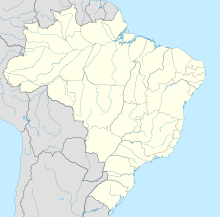Corumbá International Airport
Corumbá International Airport Aeroporto Internacional de Corumbá | |||||||||||
|---|---|---|---|---|---|---|---|---|---|---|---|
 Front entry of the airport | |||||||||||
| Summary | |||||||||||
| Airport type | Public | ||||||||||
| Operator | Infraero | ||||||||||
| Serves | Corumbá | ||||||||||
| Elevation AMSL | 141 m / 461 ft | ||||||||||
| Coordinates | 19°00′43″S 057°40′17″W / 19.01194°S 57.67139°W | ||||||||||
| Website | Infraero CMG | ||||||||||
| Map | |||||||||||
 | |||||||||||
| Runways | |||||||||||
| |||||||||||
| Statistics (2015) | |||||||||||
| |||||||||||
Corumbá International Airport (IATA: CMG, ICAO: SBCR) is the airport serving Corumbá, Brazil.
It is operated by Infraero.
History
Corumbá International Airport the second most important airport of Mato Grosso do Sul, just behind Campo Grande International Airport. Built on a site of 290 ha, it has capacity for medium size planes as a Boeing 737 and Fokker 100.
The airport was one of the first to be built outside Brazilian main centers. On September 8, 1933 Syndicato Condor established services between Rio de Janeiro, São Paulo, Corumbá and Cuiabá with wheeled tri-engine Junkers 52. This service was a major break-through because previously an overland journey to Mato Grosso took several days. In 1936 Condor made an interline agreement with Lloyd Aéreo Boliviano – LAB and established an international connection to the main cities of Bolivia, via Puerto Suárez and Santa Cruz de la Sierra, using Corumbá as connecting point. The aircraft of Condor and LAB met in Corumbá during the overnight stop and exchanged passengers. Furthermore, the services between Corumbá and Cuiabá were operated with single-engine flying boat Junkers. The connection between São Paulo and Corumbá was completed in 6 to 7 hours, and on the next day the hydroplane would make the Corumbá/Cuiabá route, returning on the following day. This wait plus the connecting services with LAB forced the tri-engine Junkers 52 to wait for more than two days in Corumbá to return to São Paulo. For this reason, in 1937 the federal government built by the air-strip a hangar with a width of 35 meters to shelter the repair work of the Junkers that had nearly 30 meters of wingspan. The hangar built with concrete and wood planks had small workshops and a passenger lobby.
On September 21, 1960 the present terminal was opened and in 1999 the whole airport complex was expanded: the passenger terminal was enlarged from 1,600m² to 2,400m², and the runway from 1,660x30m to 2,000x45m. In 2007 it received some repairs and further expansion.
Airlines and destinations
| Airlines | Destinations |
|---|---|
| Azul Brazilian Airlines | Campinas |
Accidents and incidents
- 20 August 1953: Companhia Itaú de Transportes Aéreos, a Curtiss C-46A-60-CK Commando registration PP-ITD crashed and caught fire during an emergency landing at Corumbá. Three crew members died and one survived.[4][5]
Access
The airport is located 3 km (2 mi) from downtown Corumbá.
See also
References
- ^ "Estatísticas" (in Portuguese). Infraero. 2 February 2016. Archived from the original on 4 April 2016. Retrieved 12 May 2016.
{{cite web}}: Unknown parameter|deadurl=ignored (|url-status=suggested) (help) - ^ "Airport Official Website" (in Portuguese). Infraero.
- ^ "Lista de aeródromos públicos" (in Portuguese). ANAC.
- ^ "Accident description PP-ITD". Aviation Safety Network. Archived from the original on November 4, 2012. Retrieved May 24, 2011.
{{cite web}}: Unknown parameter|deadurl=ignored (|url-status=suggested) (help) - ^ Pereira, Aldo (1987). Breve História da Aviação Comercial Brasileira (in Portuguese). Rio de Janeiro: Europa. p. 306.
External links
- Template:WAD
- Airport information for SBCR at Great Circle Mapper. Source: DAFIF (effective October 2006).
- Current weather for SBCR at NOAA/NWS
- Accident history for CMG at Aviation Safety Network

